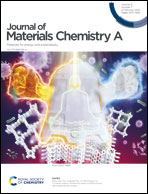A robust ethane-selective hypercrosslinked porous organic adsorbent with high ethane capacity†
Abstract
While preferential adsorption of ethane (C2H6) over ethylene (C2H4) is more advantageous in industrial separation technology, most porous materials such as metal–organic frameworks, covalent–organic frameworks, and hydrogen-bonded organic frameworks provide C2H4-selective performance, and they suffer from poor stability and large-scale synthesis problems required for practical applications. Herein, we report the synthesis and C2 gas separation properties of seven robust hypercrosslinked polymers (HCPs; HCP_TPB, HCP_TMPB, HCP_BCMBP, HCP_p-DCX, HCP_m-DCX, HCP_o-DCX, and HCP_CMBA) prepared from inexpensive starting monomers through the facile Friedel–Crafts reaction. Notably, HCP_TPB exhibited the highest C2H6 capture capacity among C2H6-selective metal-free adsorbents. The preferential C2H6 adsorption is associated with enhanced C–H⋯π interactions in the intrinsically nonpolar environments created by aromatic rings. In addition, a linear relationship between ethane uptake and surface area in porous organic frameworks was established for the first time. Breakthrough experiments demonstrated the selective separation of C2H6 from C2H6/C2H4 mixtures and the recyclability of HCP_TPB and HCP_TMPB. This work provides a design basis for the development of scalable, robust C2H6-selective adsorbents by tuning the nonpolar pore environment.



 Please wait while we load your content...
Please wait while we load your content...